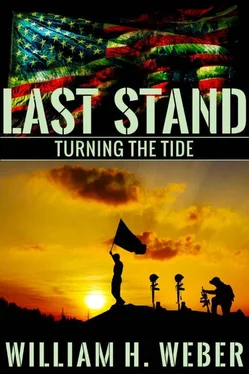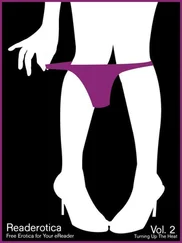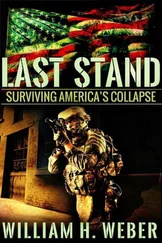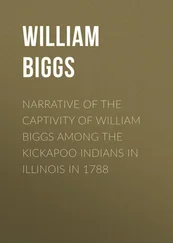Seconds later the sound of the helicopters grew louder as small dots on the horizon grew in size. Painted in a green camo pattern, the choppers prepared to make a pass over the city of Colonial Heights when the first Stinger missiles streaked into the air, leaving white vapor trails in their wake. Since the choppers were flying low to the ground, there wasn’t time for evasive maneuvers or to release flares to fool the incoming missile.
More missiles went up, exploding four of the six choppers in mid-air. Their flaming wreckage spun to the ground in slow circles, creating fireballs where they landed. The fifth chopper veered left, trying to flee, a newly fired rocket streaking up after it. The final Mi-28 fired its 30mm cannon wildly and managed to release flares as it too attempted to break contact. That was when a .50 caliber gun emplacement beneath it let loose. Sparks flew off the cockpit as it was riddled with fire. The helicopter made a lazy roll to the left and plummeted into a row of empty houses.
The main Russian formation was still over a mile away when many of the Americans rose up and cheered. One particularly boisterous bunch danced on the rooftop of a house on the northern side. Even the men along the embankment were giving each other high-fives.
“Get down and stop showboating,” John shouted to their company commanders over the radio. “This isn’t the Super Bowl.”
He’d no sooner released the actuator on his walkie when that same house across the highway exploded into a giant fireball, instantly killing the men on the roof as well as the soldiers on the nearby embankment. John watched in horror as more bombs fell all along the line. They were getting bombed from the air, likely by Sukhoi Su-27 fighters, flying at altitudes beyond the range of the American Stingers. But without spotters on the ground, their bombs were falling blind, although the effect was still devastating.
“We gotta get off this roof,” Moss said.
“And go where?” John replied. “One of those bombs hits this building, doesn’t matter if you’re on the roof or inside. You’ll be lucky if they even need a spatula to pick up what’s left of you. This is where we put our heads down and hope for the best.”
“Colonel,” Henry said over the walkie. “They’ve just taken out all of our artillery.”
The air caught in his lungs. Catching the Russian armor in tight formation with a sustained barrage of cluster munitions would have been the difference between victory and defeat. John was no longer sure they’d be able to hold this position.
When John looked out with his binoculars, he saw the main body of the Russian advance had stopped about a mile away. A secondary element of what looked like TOS-1 mobile rocket launchers moved off to set up their own firing positions. Within a matter of minutes, this stretch of highway would be as heavily cratered as the surface of the moon.
A dazzling explosion at least twenty thousand feet up in the air drew everyone’s attention. The distinct roar of a fighter jet firing its afterburners was then followed by more explosions.
For a moment John wondered what was happening, until the new jets came screaming over the American position.
“They’re ours,” Moss cried. “F-22 Raptors. Man, look at them go.”
And Moss was right in more ways than one. The bombs from overhead had stopped raining down on them, but it seemed their newfound guardians were moving off target just as quickly as they’d come.
John called Rodriguez at once.
“Compliments of General Dempsey, sir,” Rodriguez told him.
“Yes, that’s great,” John barked. “But there’s a huge column of tanks and rocket artillery about to tear us to shreds.”
“They don’t have the fuel, Colonel. I’m afraid it was all they could spare.”
No sooner had John finished than Reese was on the line. “Russian armor’s on the move.”
“They’re going to do a creeping barrage,” John said.
Moss gave him a look. “A creeping what?”
“You pepper the enemy with artillery just ahead of your advancing units. That way there’s a lot less of them to fire back at you.”
“So is it time to find a good place to hunker down yet?”
John shook his head and pushed himself to his feet. “Negative. It’s time for the last thing the Russians would ever expect. We’re gonna go on the offensive.”
•••
Within minutes, twenty members of the Rough Riders were on horseback at a full gallop, heading west along a depression of ground that ran parallel to I-81. They were armed with assault rifles, light machine guns and most important of all, AT-4 anti-tank rockets. They were about to do what guerrillas did best: sneak behind the front lines and strike the enemy where he least expected it.
On their right the metallic squeal of Russian armor pushing east toward the American position sent chills racing up John’s legs, tightening his scalp. But it was those TOS-1s and their thirty multiple rocket launcher tubes that frightened him most. Only one BTR-T infantry fighting vehicle had peeled off to support them. That meant if John’s men could get close enough to knock them out, it might just give the Americans a fighting chance.
He spotted the Russian artillery position on a small ridge, behind a clump of trees. The trees were meant to provide cover for the TOS-1s, but they also hid John’s approach. The Rough Riders wheeled right, crossing the empty highway, and stopped to dismount thirty yards from the Russian vehicles. The horses’ reins were all quickly lashed to the guard rail before the men moved to close with the enemy. John urged them on, reminding them their only chance lay in stopping those rockets from being fired.
As they reached the thin screen of trees, the soldiers with the AT-4s were ushered to the front. In the clearing beyond, John counted five TOS-1s. In front of them was a single BTR-T. He knew the fighting vehicle wasn’t to be underestimated, since this particular model had been designed using the hard lessons the Russians had learned during the war in Chechnya. Thicker armor as well as a gun with a higher traverse meant enemies in an urban environment couldn’t engage it as easily as its predecessors, the BTR-80 and BMP-2.
That was why he ordered two of his men with AT-4s to hit it first. The others would simultaneously strike the rocket artillery vehicles and thereby reduce the threat.
With his men quickly in place, John gave the hand signal to fire.
The first anti-tank rocket streaked out from the tube and impacted the turret of the BTR-T, knocking its main gun out of action. But the squad of Russian troops stormed out of the vehicle and dove to the ground, firing their weapons. John tapped Benson, his SAW gunner, on the helmet and Benson swung around, laying down an impressive volume of fire.
The other anti-tank rockets fired soon after and three of the five vehicles went up in a pillar of flame. The Russian infantry on their right were still pinned down, but a few had managed to toss hand grenades toward John’s line, killing two of his men and possibly wounding a third.
That was when the two remaining TOS-1s fired their payload. The field filled with white acrid smoke and the deafening roar of rocket motors igniting. Suddenly everything disappeared from view. The men stopped shooting and only the sound of the wounded could be heard. Slowly the air cleared about a second before the rockets found their mark. Dozens of explosions rocked the American position.
The Rough Riders charged from the treeline, killing the remaining members of the Russian infantry squad and knocking out the two remaining TOS-1s.
“Reese,” John shouted into his walkie. “Status report.”
Читать дальше












